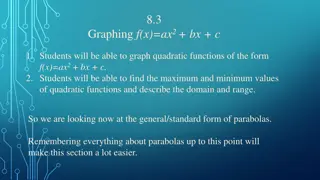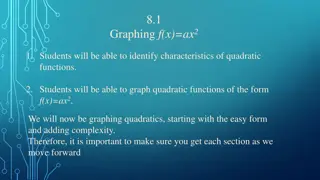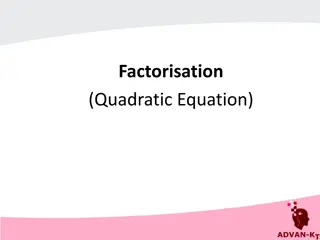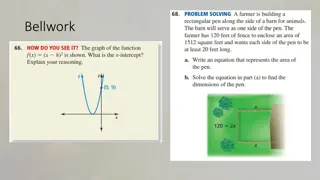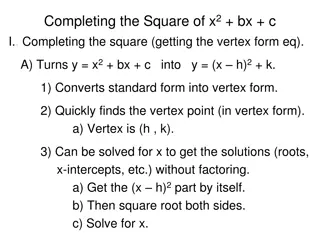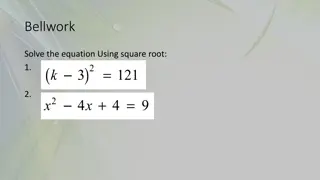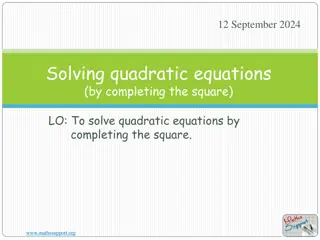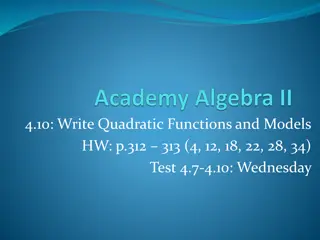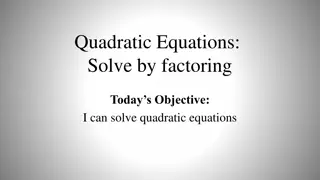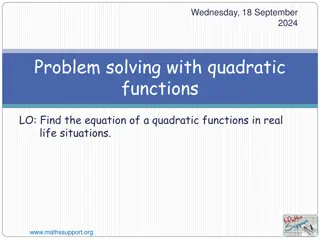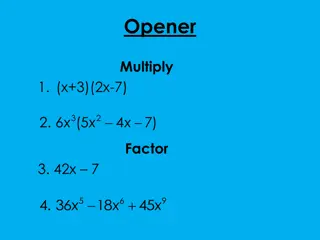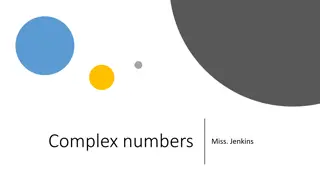Understanding Quadratic Equations: Graphing, Factoring, and Applications
Explore solving quadratic equations through graphing, factoring, and real-world applications such as finding x-intercepts and determining the roots of a quadratic function. Learn how to interpret zeros, vertices, and symmetries of quadratic functions. Engage with helpful hints, examples, and vocabulary to enhance your understanding of quadratic equations.
Download Presentation

Please find below an Image/Link to download the presentation.
The content on the website is provided AS IS for your information and personal use only. It may not be sold, licensed, or shared on other websites without obtaining consent from the author. Download presentation by click this link. If you encounter any issues during the download, it is possible that the publisher has removed the file from their server.
E N D
Presentation Transcript
Solving quadratic equations by graphing and factoring
Warm Up Find the x-intercept of each function. 1.f(x) = 3x + 9 3 2.f(x) = 6x + 4 Factor each expression. 3. 3x2 12x 3x(x 4) 4.x2 9x + 18 (x 6)(x 3) 5.x2 49 (x 7)(x + 7)
Objectives Solve quadratic equations by graphing or factoring. Determine a quadratic function from its roots.
Vocabulary zero of a function root of an equation binomial trinomial
When a soccer ball is kicked into the air, how long will the ball take to hit the ground? The height h in feet of the ball after t seconds can be modeled by the quadratic function h(t) = 16t2 + 32t. In this situation, the value of the function represents the height of the soccer ball. When the ball hits the ground, the value of the function is zero.
A zero of a function is a value of the input x that makes the output f(x) equal zero. The zeros of a function are the x-intercepts. Unlike linear functions, which have no more than one zero, quadratic functions can have two zeros, as shown at right. These zeros are always symmetric about the axis of symmetry.
Helpful Hint Recall that for the graph of a quadratic function, any pair of points with the same y-value are symmetric about the axis of symmetry.
Example 1: Finding Zeros by Using a Graph or Table Find the zeros of f(x) = x2 6x + 8 by using a graph and table. Method 1 Graph the function f(x) = x2 6x + 8. The graph opens upward because a > 0. The y-intercept is 8 because c = 8. The x-coordinate of the vertex is . Find the vertex:
Example 1 Continued Find the zeros of f(x) = x2 6x + 8 by using a graph and table. Find f(3): f(x) = x2 6x + 8 f(3) = (3)2 6(3) + 8 Substitute 3 for x. f(3) = 9 18 + 8 f(3) = 1 The vertex is (3, 1)
Example 1 Continued Plot the vertex and the y-intercept. Use symmetry and a table of values to find additional points. x 1 3 2 0 3 4 0 5 3 f(x) 1 (4, 0) (2, 0) The table and the graph indicate that the zeros are 2 and 4.
Example 1 Continued Find the zeros of f(x) = x2 6x + 8 by using a graph and table. Method 2 Use a calculator. Enter y = x2 6x + 8into a graphing calculator. Both the table and the graph show that y = 0 at x = 2 and x = 4. These are the zeros of the function.
Check It Out! Example 1 Find the zeros of g(x) = x2 2x + 3 by using a graph and a table. Method 1 Graph the function g(x) = x2 2x + 3. The graph opens downward because a < 0. The y-intercept is 3 because c = 3. The x-coordinate of the vertex is . Find the vertex:
Check It Out! Example 1 Continued Find the zeros of g(x) = x2 2x + 3 by using a graph and table. Find g(1): g(x) = x2 2x + 3 Substitute 1 for x. g( 1) = ( 1)2 2( 1) + 3 g( 1) = 1 + 2 + 3 g( 1) = 4 The vertex is ( 1, 4)
Check It Out! Example 1 Continued Plot the vertex and the y-intercept. Use symmetry and a table of values to find additional points. x 3 0 2 3 1 4 0 3 1 0 ( 3, 0) (1, 0) f(x) The table and the graph indicate that the zeros are 3 and 1.
Check It Out! Example 1 Continued Find the zeros of f(x) = x2 2x + 3 by using a graph and table. Method 2 Use a calculator. Enter y = x2 2x + 3into a graphing calculator. Both the table and the graph show that y = 0 at x = 3 and x = 1. These are the zeros of the function.
You can also find zeros by using algebra. For example, to find the zeros of f(x)= x2 + 2x 3, you can set the function equal to zero. The solutions to the related equation x2 + 2x 3 = 0 represent the zeros of the function. The solution to a quadratic equation of the form ax2 + bx + c = 0 are roots. The roots of an equation are the values of the variable that make the equation true.
You can find the roots of some quadratic equations by factoring and applying the Zero Product Property. Reading Math Functions have zeros or x-intercepts. Equations have solutions or roots.
Example 2A: Finding Zeros by Factoring Find the zeros of the function by factoring. f(x) = x2 4x 12 x2 4x 12 = 0 Set the function equal to 0. (x + 2)(x 6) = 0 Factor: Find factors of 12 that add to 4. x + 2 = 0 or x 6 = 0 Apply the Zero Product Property. x= 2 or x = 6 Solve each equation.
Example 2A Continued Find the zeros of the function by factoring. Check Substitute each value into original equation. x2 4x 12 = 0 x2 4x 12 = 0 0 ( 2)2 4( 2) 12 (6)2 4(6) 12 36 24 12 0 0 4 + 8 12 0 0 0 0 0
Example 2B: Finding Zeros by Factoring Find the zeros of the function by factoring. g(x) = 3x2 + 18x 3x2 + 18x = 0 Set the function to equal to 0. 3x(x+6) = 0 Factor: The GCF is 3x. 3x = 0 or x + 6 = 0 Apply the Zero Product Property. x = 0 or x = 6 Solve each equation.
Example 2B Continued CheckCheck algebraically and by graphing. 3x2 + 18x = 0 0 3x2 + 18x = 0 0 3( 6)2 + 18( 6) 3(0)2 + 18(0) 108 108 0 0 0 + 0 0 0 0 0 25 10 5 30
Check It Out! Example 2a Find the zeros of the function by factoring. f(x)= x2 5x 6 x2 5x 6 = 0 Set the function equal to 0. (x + 1)(x 6) = 0 Factor: Find factors of 6 that add to 5. x + 1 = 0 or x 6 = 0 Apply the Zero Product Property. x = 1 or x = 6 Solve each equation.
Check It Out! Example 2a Continued Find the zeros of the function by factoring. Check Substitute each value into original equation. x2 5x 6 = 0 x2 5x 6 = 0 0 ( 1)2 5( 1) 6 (6)2 5(6) 6 36 30 6 0 0 1 + 5 6 0 0 0 0 0
Check It Out! Example 2b Find the zeros of the function by factoring. g(x) = x2 8x x2 8x = 0 Set the function to equal to 0. x(x 8) = 0 Factor: The GCF is x. x = 0 or x 8 = 0 Apply the Zero Product Property. x = 0 or x = 8 Solve each equation.
Check It Out! Example 2b Continued Find the zeros of the function by factoring. Check Substitute each value into original equation. x2 8x = 0 x2 8x = 0 (0)2 8(0) (8)2 8(8) 64 64 0 0 0 0 0 0 0 0 0 0
Any object that is thrown or launched into the air, such as a baseball, basketball, or soccer ball, is a projectile. The general function that approximates the height h in feet of a projectile on Earth after t seconds is given. Note that this model has limitations because it does not account for air resistance, wind, and other real-world factors.
Example 3: Sports Application A golf ball is hit from ground level with an initial vertical velocity of 80 ft/s. After how many seconds will the ball hit the ground? h(t) = 16t2 + v0t + h0 Write the general projectile function. h(t) = 16t2 + 80t + 0 Substitute 80 for v0 and 0 for h0.
Example 3 Continued The ball will hit the ground when its height is zero. 16t2 + 80t = 0 Set h(t) equal to 0. 16t(t 5) = 0 Factor: The GCF is 16t. 16t = 0 or (t 5) = 0 Apply the Zero Product Property. t = 0 or t = 5 Solve each equation. The golf ball will hit the ground after 5 seconds. Notice that the height is also zero when t = 0, the instant that the golf ball is hit.
Example 3 Continued Check The graph of the function h(t) = 16t2 + 80t shows its zeros at 0 and 5. 105 3 7 15
Check It Out! Example 3 A football is kicked from ground level with an initial vertical velocity of 48 ft/s. How long is the ball in the air? h(t) = 16t2 + v0t + h0 Write the general projectile function. h(t) = 16t2 + 48t + 0 Substitute 48 for v0 and 0 for h0.
Check It Out! Example 3 Continued The ball will hit the ground when its height is zero. 16t2 + 48t = 0 Set h(t) equal to 0. 16t(t 3) = 0 Factor: The GCF is 16t. 16t = 0 or (t 3) = 0 Apply the Zero Product Property. t = 0 or t = 3 Solve each equation. The football will hit the ground after 3 seconds. Notice that the height is also zero when t = 0, the instant that the football is hit.
Check It Out! Example 3 Continued Check The graph of the function h(t) = 16t2 + 48t shows its zeros at 0 and 3. 40 1 5 15
Quadratic expressions can have one, two or three terms, such as 16t2, 16t2 + 25t, or 16t2 + 25t + 2. Quadratic expressions with two terms are binomials. Quadratic expressions with three terms are trinomials. Some quadratic expressions with perfect squares have special factoring rules.
Example 4A: Find Roots by Using Special Factors Find the roots of the equation by factoring. 4x2 = 25 4x2 25 = 0 Rewrite in standard form. (2x)2 (5)2 = 0 Write the left side as a2 b2. (2x + 5)(2x 5) = 0 Factor the difference of squares. 2x + 5 = 0 or 2x 5 = 0 Apply the Zero Product Property. Solve each equation. x = or x =
Example 4 Continued Check Graph each side of the equation on a graphing calculator. Let Y1 equal 4x2, and let Y2 equal 25. The graphs appear to intersect at and .
Example 4B: Find Roots by Using Special Factors Find the roots of the equation by factoring. 18x2 = 48x 32 18x2 48x + 32 = 0 Rewrite in standard form. 2(9x2 24x + 16) = 0 Factor. The GCF is 2. 9x2 24x + 16 = 0 Divide both sides by 2. (3x)2 2(3x)(4) + (4)2 = 0 Write the left side as a2 2ab +b2. (3x 4)2 = 0 Factor the perfect-square trinomial. 3x 4 = 0 or 3x 4 = 0 Apply the Zero Product Property. x = or x = Solve each equation.
Example 4B Continued Check Substitute the root into the original equation. 18x2 = 48x 32 48 32 18 2 18 64 32 32 32
Check It Out! Example 4a Find the roots of the equation by factoring. x2 4x = 4 x2 4x + 4 = 0 Rewrite in standard form. (x 2)(x 2) = 0 Factor the perfect-square trinomial. x 2 = 0 or x 2 = 0 Apply the Zero Product Property. x = 2 or x = 2 Solve each equation.
Check It Out! Example 4a Continued Check Substitute the root 2 into the original equation. x2 4x = 4 (2)2 4(2) 4 4 8 4 4 4
Check It Out! Example 4b Find the roots of the equation by factoring. 25x2 = 9 25x2 9= 0 Rewrite in standard form. (5x)2 (3)2 = 0 Write the left side as a2 b2. (5x + 3)(5x 3) = 0 Factor the difference of squares. 5x + 3 = 0 or 5x 3 = 0 Apply the Zero Product Property. x = or x = Solve each equation.
Check It Out! Example 4b Continued Check Graph the related function f(x) = 25x2 9 on a graphing calculator. The function appears to have zeros at and . 10 1 1 10
If you know the zeros of a function, you can work backward to write a rule for the function
Example 5: Using Zeros to Write Function Rules Write a quadratic function in standard form with zeros 4 and 7. x = 4 or x = 7 Write the zeros as solutions for two equations. x 4 = 0 or x + 7 = 0 Rewrite each equation so that it equals 0. (x 4)(x + 7) = 0 Apply the converse of the Zero Product Property to write a product that equals 0. x2 + 3x 28 = 0 Multiply the binomials. f(x) = x2 + 3x 28 Replace 0 with f(x).
Example 5 Continued 10 Check Graph the function f(x) = x2 + 3x 28 on a calculator. The graph shows the original zeros of 4 and 7. 10 10 35
Check It Out! Example 5 Write a quadratic function in standard form with zeros 5 and 5. x = 5 or x = 5 Write the zeros as solutions for two equations. x + 5 = 0 or x 5 = 0 Rewrite each equation so that it equals 0. Apply the converse of the Zero Product Property to write a product that equals 0. (x + 5)(x 5) = 0 x2 25 = 0 Multiply the binomials. f(x) = x2 25 Replace 0 with f(x).
Check It Out! Example 5 Continued 10 Check Graph the function f(x) = x2 25 on a calculator. The graph shows the original zeros of 5 and 5. 8 8 30
Note that there are many quadratic functions with the same zeros. For example, the functions f(x) = x2 x 2, g(x) = x2 + x + 2, and h(x) = 2x2 2x 4 all have zeros at 2 and 1. 5 7.6 7.6 5
Lesson Quiz: Part I Find the zeros of each function. 1.f(x)= x2 7x 0, 7 2.f(x) = x2 9x + 20 4, 5 Find the roots of each equation using factoring. 3.x2 10x + 25 = 0 5 4. 7x = 15 2x2 5,
Lesson Quiz: Part II 5. Write a quadratic function in standard form with zeros 6 and 1. Possible answer: f(x) = x2 5x 6 6. A rocket is launched from ground level with an initial vertical velocity of 176 ft/s. After how many seconds with the rocket hit the ground? after 11 s






